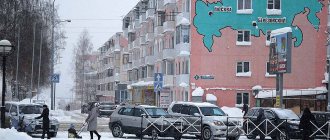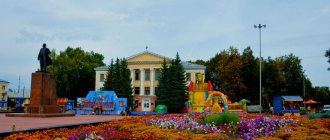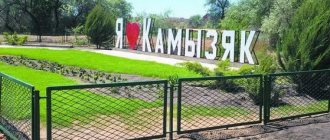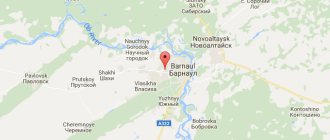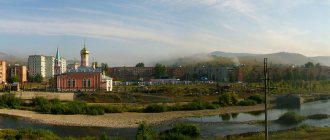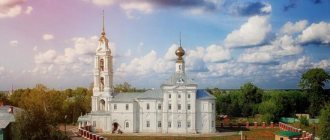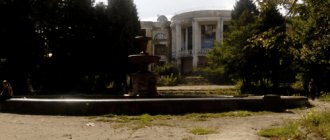Founded: 1726
City Day is celebrated
on December 4
.
In 2021, due to the pandemic, mass events in honor of the city day are canceled or may be postponed
Officially, Belovo is a relatively young city
Belovo
- a city of regional subordination in the Kemerovo region of the Russian Federation, is the administrative center of the district and is part of the Belovsky urban district. It is located in the south of Western Siberia, in the central part of Kuzbass, located approximately midway between Kemerovo and Novokuznetsk (132 and 111 kilometers respectively) and is connected to them by rail and road.
Officially Belovo is a relatively young city - December 4, 1938
By decree of the Presidium of the Supreme Soviet of the RSFSR, the workers' village of Belovo was transformed into a city. This date became City Day, but the history of the emergence of the populated area itself goes back almost three centuries.
According to surviving data, on the site where the city is now located, in 1726
Free settler (or fugitive miner) Fyodor Belov founded the settlement of the same name - Belovo on the banks of the Smorodinovaya River (as the Bachat River was called in the local dialect). And in 1762, this settlement was already mentioned in the registration lists of the Kuznetsk district as the village of Belovo, in which about 300 people lived at that time. Moreover, these were not only Russian settlers, but also representatives of the Teleut tribes, who had lived in these places since ancient times.
Bachatsky coal mine (Photo: belovo42.ru) However, for a long time Belovo remained a small village until coal mining began here.
The fact that there were large deposits of coal in the vicinity of Belovo became known in the mid-19th century; in 1851, the development of coal deposits began - the Bachatskaya mine became the first mine in Kuzbass. And Belovo received even greater development when the Kolchugino-Belovo-Usyaty railway line opened here in 1921, and the village itself became a junction railway station. In 1926 the depot was put into operation. In Soviet times, the development of the coal mining industry proceeded at an active pace, which also led to an increase in cargo transportation. In addition, in 1931 a zinc plant was launched in Belovo (its products were in great demand in the USSR), and two years later the Pionerka mine was put into operation. These industrial enterprises determined the basis of Belovo’s industrial potential for many years. And on December 4, 1938, the working village of Belovo received city status.
During the Great Patriotic War, several evacuated enterprises were located in the city, hospitals were located in schools, and the city population helped the wounded soldiers in any way they could. In the post-war years, the development of coal enterprises continued; in 1947, the first coal mine, Krasnobrodsky, was opened; in 1949, another mine, Bachatsky, produced the first coal. The city itself was actively being built, its population was growing. In September 1955, the construction of the Belovskaya State District Power Plant began, in which volunteers from all over the country took part.
Central Palace of Culture (Photo: belovo42.ru)
After the collapse of the USSR and with the beginning of the restructuring of the coal industry and the redistribution of property, many industrial giants of the city closed, but today Belovo continues to be a major industrial center of Kuzbass, occupying leading positions in many positions in the region.
The city's economy is based on enterprises of the fuel and energy complex and transport. Priority activities are electricity and mining, and primarily the coal industry. The city is located in the geological and economic zone of two main coal deposits: Belovsky and Bachatsky. The current coal industry consists of mines, open-pit mines, and processing plants. About 12% of Kuzbass crushed stone and gravel is produced here. Belovo is also a large railway and important transport hub of Kuzbass.
The city is also unique in its administrative “structure” - it practically consists of several small “towns” scattered over an area of about 219 square meters. kilometers. This is the central part of the city and remote areas, usually called workers' villages. The main water artery of Belov is the Bachat River and its tributaries.
The population of Belovo is about 70 thousand people (2021). Representatives of more than 22 nationalities live here: Russians, Tatars, Ukrainians, Chuvashs, Germans, Mordovians, Teleuts, Shors and others.
Day of the city
Residents of Belovo are celebrated annually on December 4, in honor of the date it was awarded the status of a city.
General information about the city of Belovo
The city of Belovo, founded in 1938, is located in the Ini River basin. Located in the Kuznetsk Basin, it is crossed by the Bachat and Maly Bachat rivers. The city is rich in natural water resources, plus the Belovskoye Reservoir is located in the southeast. The flat urban landscape is dominated by a continental climate. According to long-term observations, the average temperature throughout the year is about plus 0.6 ° C. Frequent fogs have become a characteristic feature associated with the proximity of the reservoir. At the moment, the number of residents of the city is 74,313 people, and with these indicators it is fourth among all cities in the Kemerovo region.
Map
| Belovo: maps |
Belovo: photo from space (Google Maps) Belovo: photo from space (Microsoft Virtual Earth)
| Belovo. Nearest cities. Distances in km. on the map (in brackets along roads) + direction. Using the hyperlink in the distance , you can get the route (information courtesy of the AutoTransInfo website) | |||
| 1 | Inskaya | 8 (15) | IN |
| 2 | New Town | 12 () | YU |
| 3 | Gramoteino | 13 (24) | WITH |
| 4 | Bachatsky | 19 () | SW |
| 5 | Polysayevo | 20 (31) | WITH |
| 6 | Leninsk-Kuznetsky | 27 (41) | WITH |
| 7 | Guryevsk | 28 (28) | SW |
| 8 | Krasnobrodsky | 30 (90) | YU |
| 9 | Salair | 38 (47) | SW |
| 10 | Kiselevsk | 50 (65) | SE |
| 11 | Prokopyevsk | 65 (82) | SE |
| 12 | Industrial | 70 (155) | NW |
| 13 | Plotnikovo | 71 (114) | WITH |
| 14 | Krapivinsky | 72 (107) | NE |
| 15 | Novokuznetsk | 91 (122) | SE |
| 16 | Metal site | 100 () | WITH |
| 17 | Kemerovo | 105 (115) | WITH |
| 18 | Fireboxes | 105 (147) | NW |
| 19 | Togul (Altai region) | 108 (219) | YU |
| 20 | Taizhina | 109 (158) | SE |
| 21 | Osinniki | 111 (145) | SE |
| 22 | Zalesovo (Altai region) | 112 (152) | SW |
| 23 | Kaltan | 118 (157) | SE |
| 24 | Zarinsk | 120 (126) | SW |
a brief description of
The city is located in the Kuznetsk basin on the river. Bachat, 170 km south of Kemerovo. Railway station.
Territory (sq. km): 219
Information about the city of Belovo on the Russian Wikipedia site
Historical sketch
Known since 1726 as the village of Belovo. Named after the fugitive peasant Fyodor Belov, who founded a zaimka (a special type of settlement) on the banks of the river. Bachat. In 1855 (1851?) the development of coal deposits began.
Workers' village of Belovo since March 20, 1931. City since 1938.
Municipal indicators
| Index | 1999 | 2001 | 2003 | 2005 |
| Demography | ||||
| Number of births, per 1000 population | 8.1 | 9.9 | 11.3 | 11.7 |
| Number of deaths, per 1000 population | 16.2 | 17.3 | 18.4 | 19.5 |
| Natural increase (decrease), per 1000 population | -8.1 | -7.4 | -7.1 | -7.8 |
| Standard of living of the population and social sphere | ||||
| Average monthly nominal accrued wages, rub. | 1933 | 3786 | 5890 | 9252 |
| Average housing area per inhabitant (at the end of the year), sq.m. | 18.6 | 19.4 | 20.2 | 21 |
| Number of preschool institutions, pcs. | 47 | 46 | 46 | 46 |
| Number of children in preschool institutions, thousand people | 4.5 | 4.7 | 4.8 | 5.2 |
| Enrollment of children in preschool educational institutions (at the end of the year), as a percentage of the number of children of the corresponding age, % | 57.4 | 59.6 | ||
| Number of daytime educational institutions (at the beginning of the school year), pcs. | 42 | 41 | 40 | 41 |
| Number of students in daytime educational institutions, thousand people | 25.2 | 23.4 | 20.3 | 18 |
| Number of doctors, people. | 595 | 551 | 542 | 534 |
| Number of nursing staff, people. | 2003 | 1765 | 1771 | 1722 |
| Number of hospital institutions, pcs. | 11 | 12 | 12 | 12 |
| Number of hospital beds, thousand units | 1.4 | 1.4 | 1.3 | 1.3 |
| Number of medical outpatient clinics, pcs. | 20 | 31 | 29 | 36 |
| Capacity of medical outpatient clinics, visits per shift, thousand units. | 3.1 | 3.1 | 3.4 | 3.4 |
| Number of registered crimes, pcs. | 2922 | 3126 | 2840 | 3210 |
| Persons who committed crimes were identified, persons. | 1907 | 2084 | 1965 | 1563 |
| Economy, industry | ||||
| Number of enterprises and organizations (at the end of the year), pcs. | 1608 | 1883 | 1988 | 2141 |
| Number of operating enterprises by type of activity: mining (at the end of the year), pcs. | 24 | |||
| Number of operating enterprises by type of activity: manufacturing (at the end of the year), pcs. | 91 | |||
| Number of operating enterprises by type of activity production and distribution of electricity, gas and water (at the end of the year), pcs. | 80 | |||
| Volume of shipped goods of own production by type of mining (in actual prices), million rubles. | 12055 | |||
| Volume of shipped goods of own production by type of manufacturing (in actual prices), million rubles. | 1020.7 | |||
| Volume of shipped goods of own production by type of production and distribution of electricity, gas and water (in actual current prices), million rubles. | 5264 | |||
| Construction | ||||
| Volume of work performed by type of activity “Construction” (until 2004 - volume of work performed under construction contracts), million rubles. | 201.3 | 381.6 | 518.4 | 1233.5 |
| Commissioning of residential buildings, thousand sq.m. of total area | 32.3 | 24.2 | 35.2 | 41.5 |
| Commissioning of residential buildings, apartments | 378 | 344 | 437 | 424 |
| Commissioning of preschool institutions, places | 0 | 0 | 0 | 0 |
| Commissioning of educational institutions, places | 0 | 0 | 1075 | 0 |
| Commissioning of hospital facilities, beds | 0 | 47 | 0 | 0 |
| Commissioning of outpatient clinics, visits per shift | 0 | 0 | 200 | 0 |
| Transport | ||||
| Number of bus routes (in intracity traffic), pcs. | 5 | 6 | 6 | 7 |
| Number of tram routes, pcs. | 0 | |||
| Number of trolleybus routes, pcs. | 0 | 0 | ||
| Number of passengers transported by buses per year (in intracity traffic), million people. | 18.1 | 19 | 10.1 | 8.5 |
| Number of passengers transported by trams per year, million people. | 0 | |||
| Number of passengers transported by trolleybuses per year, million people. | 0 | |||
| Connection | ||||
| Number of residential telephone sets of the city public telephone network, thousand units. | 13.1 | 14.5 | 16.1 | 21.4 |
| Number of payphones of the city telephone network (including universal ones), pcs. | 52 | 52 | ||
| Trade and services to the population | ||||
| Retail trade turnover (in actual prices), million rubles. | 1279 | 2474 | 3400 | 5252 |
| Retail trade turnover (in actual prices), per capita, rub. | 7679 | 15177 | 21493 | 33906 |
| Index of physical volume of retail trade turnover, % compared to the previous year | 105.1 | 115 | ||
| Public catering turnover (in actual prices), million rubles. | 45.8 | 91.7 | 117.7 | 227.8 |
| Index of physical volume of public catering turnover, % compared to the previous year | 101.3 | 127.2 | ||
| Number of stores, pavilions (at the end of the year), pcs. | 61 | 102 | ||
| Sales area of shops, pavilions (at the end of the year), sq.m. | 3771 | 5078 | ||
| Volume of paid services to the population (in actual prices), million rubles. | 314.2 | 529.9 | 852.8 | 1291.1 |
| Volume of paid services to the population (in actual prices), per capita, rub. | 1886 | 3251 | 5391 | 8335.1 |
| Volume of household services to the population (in actual prices), million rubles. | 56.3 | 98.8 | 137 | 192.5 |
| Volume of household services to the population (in actual prices), per capita, rub. | 338 | 605.9 | 866.2 | 1243 |
| Investments | ||||
| Investments in fixed assets (in actual prices), million rubles. | 752 | 1107 | 1322 | 3587.9 |
| Share of investments in fixed assets financed from budgetary funds in the total volume of investments, % | 6.3 | 9.4 | 7.5 | 4.2 |
Data sources:
- Regions of Russia. Main characteristics of the constituent entities of the Russian Federation: statistical collection. Goskomstat of Russia. - M:, 2003.
- Regions of Russia. Volume 1. Statistical collection. Goskomstat of Russia. - M:, 2001. p. 517
- Regions of Russia. Basic socio-economic indicators of cities. Statistical collection. Rosstat. - M:, 2005. p. 323
- Regions of Russia. Basic socio-economic indicators of cities. 2006. Statistical collection. Rosstat. - M:, 2006. p. 319
Universities of the city
Siberian State Transport University (Belovsky branch)
652612, Kemerovo region, Belovo, st. Lenina, 67-a
Museums, galleries, exhibition halls
Bekovsky District Historical and Ethnographic Museum 652652, Kemerovo region, Belovsky district, village.
Bekovo Phone(s): (8252) 4-3325 Exhibition hall, Vernissage gallery 652600, Kemerovo region, Belovo, st. Yubileinaya, 18 Phone(s): (38452) 2-37-45
Museum of History and Local Lore 652600, Kemerovo region, Belovo, st. Yubileinaya, 12 Phone(s): (38452) 21-605
| Population by year (thousands of inhabitants) | |||||||
| 1931 | 11.9 | 1982 | 114 | 2006 | 77.9 | 2016 | 73.4 |
| 1939 | 43.3 | 1986 | 117 | 2007 | 76.7 | 2017 | 72.8 |
| 1959 | 106.9 | 1989 | 93.1 | 2008 | 75.8 | 2018 | 72.5 |
| 1962 | 118 | 1992 | 92.3 | 2010 | 74.0 | 2019 | 71.8 |
| 1967 | 116 | 1998 | 83.7 | 2011 | 76.8 | 2020 | 71.2 |
| 1970 | 108.2 | 2000 | 80.2 | 2012 | 75.5 | 2021 | 70.6 |
| 1973 | 109 | 2001 | 78.3 | 2013 | 75.0 | ||
| 1976 | 110 | 2003 | 82.4 | 2014 | 74.3 | ||
| 1979 | 111.8 | 2005 | 79.3 | 2015 | 74.0 | ||
The history of the city of Belovo
The city of Belovo, according to historical scale, arose quite recently and can safely be called young. All settlements that appeared along the banks of the Ini River were nomadic in nature for a long time. And only in 1726 the land plot of the fugitive peasant Fyodor Belov appeared here, attached to the Kolyvano-Voskremensky mines. Only 20 years later, a small village appeared on the map, named after the surname of that very first settler. So, the city gradually grew. And its close proximity to coal deposits closely connected the local population with the mining industry.
Veteran Belovo
The city has a rich and vibrant history. In 2006, it was 280 years since the founding of the Belovo settlement.
Currently, Belovo is a city of regional subordination in the Kemerovo region of the Russian Federation. And the history of the city of Belovo began in 1726, from the moment when the fugitive mining worker Fyodor Belov founded the settlement of the same name - Belovo on the banks of the Smorodinovaya River. This is what the Bachat River was called in the local dialect. This was the beginning of our city. Fyodor Belov with his wife and two sons Semyon and Gavrila were its first Russian residents.
According to documents of 1782, in the list of populated places of the Kolyvan region, in the category of “Kuznetsk village department”, the “village of Belova” was already indicated, in which 83 people lived. According to the population registration system existing at that time, only men were registered in statistical reports, so it is quite difficult to accurately determine the number of residents of the village of Belova. So, in 1822, during the reign of Alexander I, 60 male souls lived here. Already during the abolition of serfdom in Russia, in 1861, only the male population in the village was included in the lists of 125 people. In the same year 1861. the total number of residents exceeded two and a half hundred people. Of these, 92 families were registered under the surname Belov alone.
The territory of the city of Belovo consisted not only of settlements and settlements of Russian settlers, but also of part of the former Teleut uluses. Then these were settlements with an indigenous Turkic-speaking population and villages with Russified Teleuts. The banks of the Bachat River have been inhabited by Teleut tribes since ancient times. The boundaries of the current city include the villages of Babanakovo, Chertinsky, Teleut, Zarechnoye, 8 March, and the Kaltaika microdistrict. Once upon a time these were all Teleut villages. Currently, there are two administrative territories of compact residence of the Teleut people in the city: the Teleut microdistrict and the village of Zarechnoye. In order to preserve national culture, traditions and rituals, the city hosts art festivals, national holidays, and at school in the village. In Zarechnoe, an optional study of the Teleut language is conducted. In the clubs of the Teleut microdistrict and the village. In Zarechnoe, circles and amateur associations of national folklore have been created.
Despite the fact that Belovo appeared in the first half of the 18th century, for a long time it remained a provincial village. The life of the city as a city was given by the railway, the zinc plant and the mines. The Belovo settlement experienced particularly rapid development during the years of Soviet power. In 1921, Belovo became a junction railway station, and in 1926 a depot was put into operation. In 1931, a zinc plant was launched. In the same 1931, the industrial village of Belovo became the center of the Belovsky district. In 1933, the first Pionerka mine was put into operation. These industrial enterprises determined the basis of the industrial potential of the city of Belovo, which continues to this day.
On December 4, 1938, by the Decree of the Presidium of the Supreme Soviet of the RSFSR, the workers' village of Belovo was given the status of a city.
The main economic sectors of the city of Belovo
Today, this city in Western Siberia ranks fourth in the region both in terms of population and volume of coal production. More than 20% of the electrical energy is generated in Belovo, and such indicators place the city in second place in the production of electrical energy. It is also notable for the fact that approximately 12% of crushed stone and gravel from the entire Kuzbass is produced here. And since the beginning of the 21st century, trade in the city is rapidly approaching all-Russian forms. In addition to the trade sector, the city is also represented in the cultural sphere.
Coat of arms
The coat of arms of Belovo is a heraldic shield, in the azure field of which, under a silver concave birch-leaf head, a miner's lamp of the same metal with a scarlet flame and a black safety grille, placed on two gold crossed picks, is depicted. The shield is crowned with a golden three-tower crown. As follows from the description of the symbolism of the coat of arms: “The silver chapter is a vowel emblem for the name of the city. Birch leaves indicate the emergence of a settlement in a place rich in birch forests and the initial occupation of its inhabitants - producing charcoal. In addition, birch, as a tree of birth and beginning, indicates primacy in the discovery and development of coal deposits. The lamp and pickaxes represent the coal mining mentioned above. The combination of silver and azure is intended to show the peaceful nature of the territory, its inhabitants and their work, as well as the dignity found in work. The image of pickaxes in gold is a symbol of labor glory.”
Sights of the city of Belovo
Walking along the streets you will see a large number of preserved houses of Stalinist architecture. You will be able to travel back to the middle of the 20th century and see evidence of that time - apartment barracks. Of course, there are monuments in the city. For example, the sculptural composition “Lenin with Children” is located on Sovetskaya Street not far from the Palace of Pioneers and Schoolchildren. The Palace of Culture became the place of education. Opened in 1983, today it has become a haven for 32 amateur groups. You can also look into the Museum of Mining Glory, located in the Palace of Culture of Coal Miners.
In general, you can take a walking tour of the city of Belovo in one hour.
